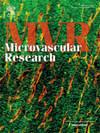Association between posterior vitreous detachment stage and quantitative neovascularization morphology in proliferative diabetic retinopathy using wide-field swept-source optical coherence tomography angiography
IF 2.7
4区 医学
Q2 PERIPHERAL VASCULAR DISEASE
引用次数: 0
Abstract
Purpose
To investigate the association between posterior vitreous detachment (PVD) and the progression of proliferative diabetic retinopathy (PDR) by analyzing the morphological evolution of neovascularization (NV) across PVD stages using swept-source optical coherence tomography angiography (SS-OCTA).
Methods
This retrospective study assessed PVD stages via SS-OCT. Quantitative analysis of SS-OCTA images was performed with ImageJ and AngioTool to extract NV morphological features including perimeter, MaxFeret, MiniFeret, Feret ratio (FR), maximum vessel caliber, vessel dispersion, fractal dimension index (FDI), vessel area (VA), vessel density, total vessel length (TVL), average vessel length (AVL), total number of junctions (TNJ), junction density (JD), total number of endpoints, endpoint density (ED), and mean lacunarity (MEL) to assess NV size, activity, and complexity. Analysis of NV morphology and PVD association via Generalized Linear Mixed Model.
Results
Significant differences (P < 0.05) in multiple NV parameters were observed across PVD stages in the 74 included eyes. At stage 4, most parameters reached their minima, except for JD and ED, which peaked. Trend analysis revealed inverted U-shaped trajectories for size (perimeter, MaxFeret, MiniFeret, VA), activity (TNJ, TVL, AVL), and complexity (FDI) parameters with PVD progression. In contrast, JD and ED followed U-shaped trends. All inflection points clustered between stages 1 and 2.
Conclusions
NV morphology in PDR evolves systematically from a highly intricate and extensive structure in early PVD (Stage 1 or 2) to a simplified and localized architecture in stage 4. Concomitant alterations in NV activity and complexity likely occur, providing morphological insights into PVD's role in PDR.
增生性糖尿病视网膜病变后玻璃体脱离阶段与定量新生血管形态的关系。
目的:通过扫描源光学相干断层扫描血管造影(SS-OCTA)分析PVD分期新生血管(NV)的形态学演变,探讨玻璃体后脱离(PVD)与增生性糖尿病视网膜病变(PDR)进展之间的关系。方法:本回顾性研究通过SS-OCT评估PVD分期。使用ImageJ和AngioTool对SS-OCTA图像进行定量分析,提取NV形态学特征,包括周长、MaxFeret、MiniFeret、Feret比率(FR)、最大血管直径、血管离散度、分形维指数(FDI)、血管面积(VA)、血管密度、血管总长度(TVL)、血管平均长度(AVL)、总结数(TNJ)、结密度(JD)、总端点数、端点密度(ED)和平均间隙度(MEL),以评估NV大小。活动和复杂性。广义线性混合模型分析NV形态与PVD关联。结果:显著差异(P 结论:PDR的NV形态系统地从早期PVD(1或2期)的高度复杂和广泛的结构演变为4期的简化和局部结构。同时可能发生NV活性和复杂性的改变,这为PVD在PDR中的作用提供了形态学上的见解。
本文章由计算机程序翻译,如有差异,请以英文原文为准。
求助全文
约1分钟内获得全文
求助全文
来源期刊

Microvascular research
医学-外周血管病
CiteScore
6.00
自引率
3.20%
发文量
158
审稿时长
43 days
期刊介绍:
Microvascular Research is dedicated to the dissemination of fundamental information related to the microvascular field. Full-length articles presenting the results of original research and brief communications are featured.
Research Areas include:
• Angiogenesis
• Biochemistry
• Bioengineering
• Biomathematics
• Biophysics
• Cancer
• Circulatory homeostasis
• Comparative physiology
• Drug delivery
• Neuropharmacology
• Microvascular pathology
• Rheology
• Tissue Engineering.
 求助内容:
求助内容: 应助结果提醒方式:
应助结果提醒方式:


